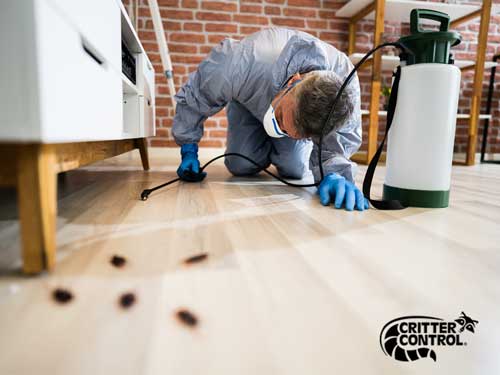Bed Pest Treatment Malfunction: Comparing Chemical Vs. Non-Chemical Solutions
In the world of pest control, specifically when taking care of the relentless issue of bed insects, the option between chemical and non-chemical treatment solutions can be an essential one. Both approaches use distinct advantages and disadvantages, influencing elements such as performance, safety and security factors to consider, and general cost. By examining the nuanced information of each approach, a more clear understanding of which path to pursue in attending to a bed bug infestation can be obtained.
Efficiency of Chemical Treatments
Chemical treatments for bed insect infestations have been extensively identified for their fast and potent efficiency in removing these parasites. When thinking about the efficiency of chemical treatments, it is crucial to recognize that they can supply a fast and comprehensive solution to a bed bug issue.
Moreover, chemical therapies have the benefit of offering residual impacts, indicating that they can remain to eliminate bed insects even after the first application. This recurring action is specifically helpful in combating any kind of prospective re-infestations. Furthermore, the fast activity of chemical therapies can bring alleviation to people encountering extreme bed pest infestations, allowing them to restore control of their home rapidly.
Safety And Security Problems With Chemical Solutions
One crucial aspect that needs mindful consideration when using chemical options for bed insect treatment is guaranteeing the safety and security of passengers and the atmosphere. While chemical treatments can be efficient in getting rid of bed insects, they might pose dangers otherwise managed appropriately. One of the key security worry about chemical solutions is the possible damage they can create to human wellness. Exposure to specific chemicals utilized in bed bug treatments can result in breathing concerns, skin irritation, or other adverse responses, specifically in individuals with pre-existing problems or sensitivities. In addition, inappropriate application or dose of chemical pesticides can cause hazardous deposits remaining in the treated area, posturing lasting health and wellness threats to residents.
Additionally, the ecological effect of chemical services is one more substantial consideration. Some chemicals used in bed bug treatments might be hazardous to beneficial bugs, wild animals, and environments if they seep into the dirt or water supply. It is important to make use of chemical treatments carefully, adhering to security guidelines, and taking into consideration less hazardous choices to alleviate these risks and make sure the safe and reliable administration of bed insect infestations.
Benefits of Non-Chemical Strategies
Taking into consideration the potential safety concerns and ecological effect associated with chemical services for bed insect treatment, exploring non-chemical strategies provides an encouraging alternative with numerous unique benefits. Non-chemical therapies are eco friendly, as they do not add to air or water pollution, making them a lasting option for pest control.
Furthermore, non-chemical remedies can be efficient in targeting bed bugs, consisting of hard-to-reach locations where chemical treatments might not permeate. Approaches such as heat treatment, vacuuming, vapor cleaning, and cushion encasements supply thorough removal without using damaging chemicals. Moreover, non-chemical approaches can be much less disruptive, needing marginal preparation and permitting quicker reentry right into treated locations. Overall, choosing for non-chemical bed insect therapy methods not only focuses on security and environmental management yet also makes certain detailed and reliable pest control.
Limitations of Non-Chemical Treatments

In addition, non-chemical therapies typically call for multiple applications to accomplish successful elimination. This can be taxing and may not always assure total removal of all bed bugs and their eggs, especially in covert or hard-to-reach areas.
Additionally, the success of non-chemical treatments greatly relies on proper implementation and thoroughness, which can be testing for people without professional experience. Inadequate application of non-chemical techniques might cause insufficient eradication, resulting in relentless problems and the need for extra treatments.
As a result, while non-chemical therapies have their benefits, it is important to acknowledge these restrictions and consider them when establishing one of the most efficient approach for managing bed bug infestations.
Expense Contrast: Chemical Vs. Non-Chemical Options
Provided the restrictions related to non-chemical treatments, a vital element to examine in the context of bed pest monitoring is the price contrast between chemical and non-chemical alternatives. Chemical treatments usually involve the application of insecticides by specialists, which can vary from $250 to $900 per room, relying on the seriousness of the infestation and the dimension of the area to be dealt with. On the other hand, non-chemical therapies like warm therapy or heavy steam can be extra costly, with costs ranging from $1,000 to $6,000 for a whole home. While the first cost of chemical therapies might seem lower, several treatments might be needed to fully eradicate the problem, possibly boosting the overall price. On the various other hand, non-chemical alternatives might supply a much more environment-friendly and sustainable solution, although they can be cost-prohibitive for some people. Ultimately, when considering the price of bed bug treatment choices, it is necessary to weigh the in advance expenditures versus the effectiveness and lasting sustainability of the chosen technique.
Conclusion

Considering the prospective safety problems and environmental effect linked with chemical solutions for bed insect therapy, exploring non-chemical techniques offers a promising option with a number of distinctive benefits.Provided the restrictions associated with non-chemical therapies, a necessary read what he said aspect to examine in the context of bed pest monitoring is the cost comparison between chemical and non-chemical choices. In contrast, non-chemical therapies like warm treatment or heavy steam can be a lot more pricey, with prices varying from $1,000 to $6,000 for an entire home. While the preliminary expense of chemical treatments may appear check this site out reduced, several treatments may be needed to completely get rid of the problem, potentially increasing the overall cost.In final thought, when comparing chemical and non-chemical bed bug therapy choices, it is essential to consider effectiveness, safety and security, advantages, limitations, and cost.